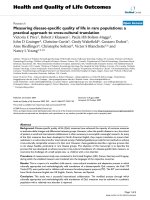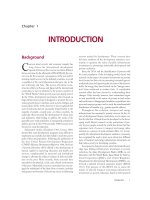Fundamentals of Global Positioning System Receivers A Software Approach - Chapter 1 docx
Bạn đang xem bản rút gọn của tài liệu. Xem và tải ngay bản đầy đủ của tài liệu tại đây (315.1 KB, 20 trang )
Fundamentals of
Global Positioning
System Receivers
A Software Approach
JAMES BAO-YEN TSUI
A WILEY INTERSCIENCE PUBLICATION
JOHN WILEY & SONS, INC.
NEW YORK/CHICHESTER/WEINHEIM /BRISBANE/SINGAPORE /TORONTO
Designations used by companies to distinguish their products are often claimed as trademarks.
In all instances where John Wiley & Sons, Inc., is aware of a claim, the product names
appear in initial capital or ALL CAPITAL LETTERS. Readers, however, should contact the
appropriate companies for more complete information regarding trademarks and registration.
Copyright
2000 by John Wiley & Sons, Inc. All rights reserved.
No part of this publication may be reproduced, stored in a retrieval system or transmitted
in any form or by any means, electronic or mechanical, including uploading, downloading,
printing, decompiling, recording or otherwise, except as permitted under Sections
107 or 108
of the 1976 United States Copyright Act, without the prior written permission of the Publisher.
Requests to the Publisher for permission should be addressed to the Permissions Department,
John Wiley & Sons, Inc.,
605 Third Avenue, New York, NY 10158-0012, (212) 850-6011, fax
(
212) 850-6008, E-Mail: PERMREQ @ WILEY.COM.
This publication is designed to provide accurate and authoritative information in regard to the
subject matter covered. It is sold with the understanding that the publisher is not engaged in
rendering professional services. If professional advice or other expert assistance is required, the
services of a competent professional person should be sought.
ISBN
0-471-20054-9
This title is also available in print as ISBN 0-471-38154-3.
For more information about Wiley products, visit our web site at www.Wiley.com.
To my wife and mother.
In memory of my father and parents-in-law.
vii
Contents
Preface xiii
Notations and Constants xv
Chapter
1 Introduction 1
1.1 Introduction 1
1
.2 History of GPS Development 1
1
.3 A Basic GPS Receiver 2
1
.4 Approaches of Presentation 3
1
.5 Software Approach 3
1
.6 Potential Advantages of the Software Approach 4
1
.7 Organization of the Book 5
Chapter 2 Basic GPS Concept 7
2.1 Introduction 7
2
.2 GPS Performance Requirements 7
2
.3 Basic GPS Concept 8
2
.4 Basic Equations for Finding User Position 10
2
.5 Measurement of Pseudorange 11
2
.6 Solution of User Position from Pseudoranges 12
2
.7 Position Solution with More Than Four Satellites 14
2
.8 User Position in Spherical Coordinate System 16
2
.9 Earth Geometry 17
2
.10 Basic Relationships in an Ellipse 18
2
.11 Calculation of Altitude 20
2
.12 Calculation of Geodetic Latitude 21
2
.13 Calculation of a Point on the Surface of the Earth 24
2
.14 Satellite Selection 25
2
.15 Dilution of Precision 27
2
.16 Summary 28
viii CONTENTS
Chapter 3 Satellite Constellation 32
3.1 Introduction 32
3.2 Control Segment of the GPS System 33
3
.3 Satellite Constellation 33
3
.4 Maximum Differential Power Level from Different
Satellites
34
3
.5 Sidereal Day 35
3.6 Doppler Frequency Shift 36
3
.7 Average Rate of Change of the Doppler Frequency 40
3
.8 Maximum Rate of Change of the Doppler
Frequency
41
3
.9 Rate of Change of the Doppler Frequency Due
to User Acceleration
42
3
.10 Kepler’s Laws 43
3
.11 Kepler’s Equation 45
3.12 True and Mean Anomaly 47
3
.13 Signal Strength at User Location 50
3
.14 Summary 52
Chapter 4 Earth-Centered, Earth-Fixed Coordinate System 54
4.1 Introduction 54
4
.2 Direction Cosine Matrix 55
4
.3 Satellite Orbit Frame to Equator Frame Transform 57
4
.4 Vernal Equinox 60
4.5 Earth Rotation 61
4
.6 Overall Transform from Orbit Frame to Earth-
Centered, Earth-Fixed Frame
63
4
.7 Perturbations 64
4
.8 Correction of GPS System Time at Time of
Transmission
66
4
.9 Calculation of Satellite Position 68
4.10 Coordinate Adjustment for Satellites 69
4
.11 Ephemeris Data 71
4
.12 Summary 71
Chapter 5 GPS C
/
A Code Signal Structure 73
5.1 Introduction 73
5.2 Transmitting Frequency 74
5
.3 Code Division-Multiple Access (CDMA) Signals 76
5
.4 P Code 76
5
.5 C
/
A Code and Data Format 77
5
.6 Generation of C
/
A Code 78
5
.7 Correlation Properties of C
/
A Code 83
CONTENTS ix
5.8 Navigation Data Bits 84
5
.9 Telemetry (TLM) and Hand Over Word (HOW) 85
5
.10 GPS Time and the Satellite Z Count 86
5
.11 Parity Check Algorithm 88
5
.12 Navigation Data from Subframe 190
5
.13 Navigation Data from Subframes 2 and 394
5
.14 Navigation Data from Subframes 4 and 5—Support
Data
96
5
.15 Ionospheric Model 102
5
.16 Tropospheric Model 104
5
.17 Selectivity Availability (SA) and Typical Position
Errors
104
5
.18 Summary 105
Chapter 6 Receiver Hardware Considerations 109
6.1 Introduction 109
6
.2 Antenna 110
6
.3 Amplification Consideration 111
6
.4 Two Possible Arrangements of Digitization by
Frequency Plans
114
6
.5 First Component After the Antenna 115
6
.6 Selecting Sampling Frequency as a Function of the
C
/
A Code Chip Rate 115
6
.7 Sampling Frequency and Band Aliasing for Real
Data Collection
117
6
.8 Down-converted RF Front End for Real Data
Collection
119
6
.9 Direct Digitization for Real Data Collection 121
6
.10 In-Phase (I) and Quadrant-Phase (Q) Down
Conversion
122
6
.11 Aliasing Two or More Input Bands into a Baseband 123
6
.12 Quantization Levels 126
6
.13 Hilbert Transform 127
6
.14 Change from Complex to Real Data 129
6
.15 Effect of Sampling Frequency Accuracy 130
6
.16 Summary 131
Chapter 7 Acquisition of GPS C
/
A Code Signals 133
7.1 Introduction 133
7
.2 Acquisition Methodology 134
7
.3 Maximum Data Length for Acquisition 135
7
.4 Frequency Steps in Acquisition 136
7.5 C
/
A Code Multiplication and Fast Fourier
Transform (FFT)
137
x CONTENTS
7.6 Time Domain Correlation 138
7
.7 Circular Convolution and Circular Correlation 140
7
.8 Acquisition by Circular Correlation 143
7
.9 Modified Acquisition by Circular Correlation 144
7
.10 Delay and Multiply Approach 146
7
.11 Noncoherent Integration 149
7
.12 Coherent Processing of a Long Record of Data 149
7
.13 Basic Concept of Fine Frequency Estimation 150
7
.14 Resolving Ambiguity in Fine Frequency
Measurements
151
7
.15 An Example of Acquisition 156
7
.16 Summary 159
Chapter 8 Tracking GPS Signals 165
8.1 Introduction 165
8
.2 Basic Phase-locked Loops 166
8
.3 First-Order Phase-locked Loop 168
8
.4 Second-Order Phase-locked Loop 169
8
.5 Transform from Continuous to Discrete Systems 171
8
.6 Carrier and Code Tracking 173
8
.7 Using the Phase-locked Loop to Track GPS
Signals
175
8
.8 Carrier Frequency Update for the Block Adjustment
of Synchronizing Signal (BASS) Approach
176
8
.9 Discontinuity in Kernel Function 178
8
.10 Accuracy of the Beginning of C
/
A Code
Measurement
180
8
.11 Fine Time Resolution Through Ideal Correlation
Outputs
182
8
.12 Fine Time Resolution Through Curve Fitting 186
8
.13 Outputs from the BASS Tracking Program 188
8
.14 Combining RF and C
/
A Code 189
8
.15 Tracking of Longer Data and First Phase Transition 190
8
.16 Summary 190
Appendix 190
Chapter 9 GPS Software Receivers 193
9.1 Introduction 193
9
.2 Information Obtained from Tracking Results 194
9
.3 Converting Tracking Outputs to Navigation Data 196
9
.4 Subframe Matching and Parity Check 198
9
.5 Obtaining Ephemeris Data from Subframe 1199
9.6 Obtaining Ephemeris Data from Subframe 2200
9.7 Obtaining Ephemeris Data from Subframe 3201
CONTENTS xi
9.8 Typical Values of Ephemeris Data 202
9
.9 Finding Pseudorange 202
9
.10 GPS System Time at Time of Transmission
Corrected by Transit Time (t
c
) 209
9
.11 Calculation of Satellite Position 210
9
.12 Calculation of User Position in Cartesian Coordinate
System
212
9
.13 Adjustment of Coordinate System of Satellites 213
9
.14 Changing User Position to Coordinate System of
the Earth
214
9
.15 Transition from Acquisition to Tracking Program 215
9
.16 Summary 217
Index 235
xiii
Preface
The purpose of this book is to present detailed fundamental information on a
global positioning system (GPS) receiver. Although GPS receivers are popu-
larly used in every-day life, their operation principles cannot be easily found
in one book. Most other types of receivers process the input signals to obtain
the necessary information easily, such as in amplitude modulation (AM) and
frequency modulation (FM) radios. In a GPS receiver the signal is processed
to obtain the required information, which in turn is used to calculate the user
position. Therefore, at least two areas of discipline, receiver technology and
navigation scheme, are employed in a GPS receiver. This book covers both
areas.
In the case of GPS signals, there are two sets of information: the civilian
code, referred to as the coarse
/
acquisition (C
/
A) code, and the classified mil-
itary code, referred to as the P(Y) code. This book concentrates only on the
civilian C
/
A code. This is the information used by commercial GPS receivers
to obtain the user position.
The material in this book is presented from the software receiver viewpoint
for two reasons. First, it is likely that narrow band receivers, such as the GPS
receiver, will be implemented in software in the future. Second, a software
receiver approach may explain the operation better. A few key computer pro-
grams can be used to further illustrate some points.
This book is written for engineers and scientists who intend to study and
understand the detailed operation principles of GPS receivers. The book is at
the senior or graduate school level. A few computer programs written in Matlab
are listed at the end of several chapters to help the reader understand some of
the ideas presented.
I would like to acknowledge the following persons. My sincere appreciation
to three engineers: Dr. D. M. Akos from Stanford University, M. Stockmaster
from Rockwell Collins, and J. Schamus from Veridian. They worked with me
at the Air Force Research Laboratory, Wright Patterson Air Force Base on the
xiv PREFACE
design of a software GPS receiver. This work made this book possible. Dr.
Akos also reviewed my manuscripts. I used information from several courses
on GPS receivers given at the Air Force Institute of Technology by Lt. Col.
B. Riggins, Ph.D. and Capt. J. Requet, Ph.D. Valuable discussion with Drs.
F. VanGraas and M. Braasch from Ohio University helped me as well. I am
constantly discussing GPS subjects with my coworkers, D. M. Lin and V. D.
Chakravarthy.
The management in the Sensor Division of the Air Force Research Labo-
ratory provided excellent guidance and support in GPS receiver research. Spe-
cial thanks are extended to Dr. P. S. Hadorn, E. R. Martinsek, A. W. White,
and N. A. Pequignot. I would also like to thank my colleagues, R. L. Davis,
S. M. Rodrigue, K. M. Graves, J. R. McCall, J. A. Tenbarge, Dr. S. W. Schnei-
der, J. N. Hedge Jr., J. Caschera, J. Mudd, J. P. Stephens, Capt. R. S. Parks,
P. G. Howe, D. L. Howell, Dr. L. L. Liou, D. R. Meeks, and D. Jones, for their
consultation and assistance.
Last, but not least, I would like to thank my wife, Susan, for her encourage-
ment and understanding.
xv
Notations and Constants
a
e
6378137 ± 2 m is the semi-major axis of the earth.
a
f 0
is the satellite clock correction parameter.
a
f 1
is the satellite clock correction parameter.
a
f 2
is the satellite clock correction parameter.
a
s
is the semi-major axis of the satellite orbit
Db
i
is the satellite clock error.
b
e
6356752.3142 m is the semi-minor axis of the earth.
b
s
is the semi-minor axis of the satellite orbit
b
u
is the user clock bias error, expressed in distance, which is related to the
quantity b
ut
by b
u
cb
ut
.
b
ut
is the user clock error.
c
2.99792458 × 10
8
meter
/
sec is the speed of light.
C
ic
is the amplitude of the cosine harmonic correction term to the angle of
inclination.
C
is
is the amplitude of the sine harmonic correction term to the angle of
inclination.
C
rc
is the amplitude of the cosine harmonic correction term to the orbit
radius.
C
rs
is the amplitude of the sine harmonic correction term to the orbit radius.
c
s
is the distance from the center of the ellipse to a focus.
C
uc
is the amplitude of the cosine harmonic correction term to the argument
of latitude.
C
us
is the amplitude of the sine harmonic correction term to the argument
of latitude.
DD
i
is the satellite position error effect on range.
E is called eccentric anomaly.
xvi NOTATIONS AND CONSTANTS
e
e
0.0818191908426 is the eccentricity of the earth.
e
p
0.00335281066474 is the ellipticity of the earth.
e
s
is the eccentricity of the satellite orbit.
F
4.442807633 × 10
10
sec
/
m
1
/
2
.
f
I
is the input frequency.
f
0
is the output frequency in baseband.
f
s
is the sampling frequency.
h is altitude.
i is the inclination angle at reference time.
idot is the rate of inclination angle.
DI
i
is the ionospheric delay error.
l is longitude.
L is geodetic latitude often used in maps.
L
c
is geocentric latitude.
M is mean anomaly.
M
0
is the mean anomaly at reference time.
Dn is the mean motion difference from computed value.
r
e
6368 km is average earth radius.
r
0
is the distance from the center of the earth to the point on the surface of
the earth under the user position.
r
0i
is the average radius of an ideal spherical earth.
r
s
is the average radius of the satellite orbit.
t is the GPS time at time of transmission corrected for transit time.
t
c
is the coarse GPS system time at time of transmission corrected for transit
time.
T
GD
is the satellite group delay differential.
DT
i
is the tropospheric delay error.
t
oc
is the satellite clock correction parameter.
t
oe
is the reference time ephemeris.
t
p
is the time when the satellite passes the perigee.
t
si
is referred to as the true time of transmission from satellite i.
t
t
is the transit time (time for the signal from the satellite to travel to the
receiver).
t
u
is the time of reception.
v
s
is the speed of the satellite.
m
3.986005 × 10
14
meters
3
/
sec
2
is the earth’s universal gravitational
parameter.
u
i
is the receiver measurement noise error.
Du
i
is the relativistic time correction.
NOTATIONS AND CONSTANTS xvii
p 3.1415926535898.
r
iT
is the true value of pseudorange from user to satellite i.
r
i
is the measured pseudorange from user to satellite i
q is the argument of the perigee.
Q
e
(Q a) is the modified right ascension angle.
Q
e
is the longitude of ascending node of orbit plane at weekly epoch.
Q
er
is the angle between the ascending node and the Greenwich meridian.
˙
Q is the rate of the right ascension.
˙
Q
ie
7.2921151467 × 10
5
rad
/
sec is the WGS-84 value of the earth’s rota-
tion rate.
Fundamentals of Global Positioning System Receivers: A Software Approach
James Bao-Yen Tsui
Copyright
2000 John Wiley & Sons, Inc.
Print ISBN
0-471-38154-3 Electronic ISBN 0-471-20054-9
1
CHAPTER ONE
Introduction
1.1 INTRODUCTION
(1–13)
This book presents detailed information in a compact form about the global
positioning system (GPS) coarse
/
acquisition (C
/
A) code receiver. Using the
C
/
A code to find the user location is referred to as the standard position service
(SPS). Most of the information can be found in references
1 through 13. How-
ever, there is much more information in the references than the basics required
to understand a GPS receiver. Therefore, one must study the proper subjects
and put them together. This is a tedious and cumbersome task. This book does
this job for the reader.
This book not only introduces the information available from the references,
it emphasizes its applications. Software programs are provided to help under-
stand some of the concepts. These programs are also useful in designing GPS
receivers. In addition, various techniques to perform acquisition and tracking
on the GPS signals are included.
This book concentrates only on the very basic concepts of the C
/
A code
GPS receiver. Any subject not directly related to the basic receiver (even if
it is of general interest, i.e., differential GPS receiver and GPS receiver with
carrier-aided tracking capacity) will not be included in this book. These other
subjects can be found in reference
1.
1.2 HISTORY OF GPS DEVELOPMENT
(1,5,12)
The discovery of navigation seems to have occurred early in human history.
According to Chinese storytelling, the compass was discovered and used in wars
during foggy weather before recorded history. There have been many different
navigation techniques to support ocean and air transportation. Satellite-based
navigation started in the early
1970s. Three satellite systems were explored
2 INTRODUCTION
before the GPS programs: the U.S. Navy Navigation Satellite System (also
referred to as the Transit), the U.S. Navy’s Timation (TIMe navigATION), and
U.S. Air Force project
621B. The Transit project used a continuous wave (cw)
signal. The closest approach of the satellite can be found by measuring the
maximum rate of Doppler shift. The Timation program used an atomic clock
that improves the prediction of satellite orbits and reduces the ground control
update rate. The Air Force
621B project used the pseudorandom noise (PRN)
signal to modulate the carrier frequency.
The GPS program was approved in December
1973. The first satellite was
launched in
1978. In August 1993, GPS had 24 satellites in orbit and in Decem-
ber of the same year the initial operational capability was established. In February
1994, the Federal Aviation Agency (FAA) declared GPS ready for aviation use.
1.3 A BASIC GPS RECEIVER
The basic GPS receiver discussed in this book is shown in Figure 1.1. The sig-
nals transmitted from the GPS satellites are received from the antenna. Through
the radio frequency (RF) chain the input signal is amplified to a proper ampli-
tude and the frequency is converted to a desired output frequency. An analog-
to-digital converter (ADC) is used to digitize the output signal. The antenna,
RF chain, and ADC are the hardware used in the receiver.
After the signal is digitized, software is used to process it, and that is why this
book has taken a software approach. Acquisition means to find the signal of a
certain satellite. The tracking program is used to find the phase transition of the
navigation data. In a conventional receiver, the acquisition and tracking are per-
formed by hardware. From the navigation data phase transition the subframes
and navigation data can be obtained. Ephemeris data and pseudoranges can be
FIGURE 1.1 A fundamental GPS receiver.
1.4 APPROACHES OF PRESENTATION 3
obtained from the navigation data. The ephemeris data are used to obtain the
satellite positions. Finally, the user position can be calculated for the satellite
positions and the pseudoranges. Both the hardware used to collect digitized data
and the software used to find the user position will be discussed in this book.
1.4 APPROACHES OF PRESENTATION
There are two possible approaches to writing this book. One is a straightforward
way to follow the signal flow shown in Figure
1.1. In this approach the book
would start with the signal structure of the GPS system and the methods to pro-
cess the signal to obtain the necessary the information. This information would
be used to calculate the positions of the satellites and the pseudoranges. By
using the positions of the satellites and the pseudoranges the user position can
be found. In this approach, the flow of discussion would be smooth, from one
subject to another. However, the disadvantage of this approach is that readers
might not have a clear idea why these steps are needed. They could understand
the concept of the GPS operation only after reading the entire book.
The other approach is to start with the basic concept of the GPS from a
system designers’ point of view. This approach would start with the basic con-
cept of finding the user position from the satellite positions. The description
of the satellite constellation would be presented. The detailed information of
the satellite orbit is contained in the GPS data. In order to obtain these data,
the GPS signal must be tracked. The C
/
A code of the GPS signals would then
be presented. Each satellite has an unique C
/
A code. A receiver can perform
acquisition on the C
/
A code to find the signal. Once the C
/
A code of a certain
satellite is found, the signal can be tracked. The tracking program can produce
the navigation data. From these data, the position of the satellite can be found.
The relative pseudorange can be obtained by comparing the time a certain data
point arrived at the receiver. The user position can be calculated from the satel-
lite positions and pseudoranges of several satellites.
This book takes this second approach to present the material because it
should give a clearer idea of the GPS function from the very beginning. The
final chapter describes the overall functions of the GPS receiver and can be
considered as taking the first approach for digitizing the signal, performing
acquisition and tracking, extracting the navigation data, and calculating the user
position.
1.5 SOFTWARE APPROACH
This book uses the concept of software radio to present the subject. The soft-
ware radio idea is to use an analog-to-digital converter (ADC) to change the
input signal into digital data at the earliest possible stage in the receiver. In
other words, the input signal is digitized as close to the antenna as possible.
4 INTRODUCTION
Once the signal is digitized, digital signal processing will be used to obtain
the necessary information. The primary goal of the software radio is minimum
hardware use in a radio. Conceptually, one can tune the radio through software
or even change the function of the radio such as from amplitude modulation
(AM) to frequency modulation (FM) by changing the software; therefore great
flexibility can be achieved.
The main purpose of using the software radio concept to present this subject
is to illustrate the idea of signal acquisition and tracking. Although using hard-
ware to perform signal acquisition and tracking can also describe GPS receiver
function, it appears that using software may provide a clearer idea of the sig-
nal acquisition and tracking. In addition, a software approach should provide a
better understanding of the receiver function because some of the calculations
can be illustrated with programs. Once the software concept is well understood,
the readers should be able to introduce new solutions to problems such as var-
ious acquisition and tracking methods to improve efficiency and performance.
At the time (December
1997) this chapter was being written, a software GPS
receiver using a
200 MHz personal computer (PC) could not track one satellite
in real time. When this chapter was revised in December
1998, the software
had been modified to track two satellites in real time with a new PC operat-
ing at
400 MHz. Although it is still impossible to implement a software GPS
receiver operating in real time, with the improvement in PC operating speed and
software modification it is likely that by the time this book is published a soft-
ware GPS receiver will be a reality. Of course, using a digital signal processing
(DSP) chip is another viable way to build the receiver.
Only the fundamentals of a GPS receiver are presented in this book. In order
to improve the performance of a receiver, fine tuning of some of the operations
might be necessary. Once readers understand the basic operation principles of
the receiver, they can make the necessary improvement.
1.6 POTENTIAL ADVANTAGES OF THE SOFTWARE APPROACH
An important aspect of using the software approach to build a GPS receiver
is that the approach can drastically deviate from the conventional hardware
approach. For example, the user may take a snapshot of data and process them
to find the location rather than continuously tracking the signal. Theoretically,
30 seconds of data are enough to find the user location. This is especially use-
ful when data cannot be collected in a continuous manner. Since the software
approach is in the infant stage, one can explore many potential methods.
The software approach is very flexible. It can process data collected from
various types of hardware. For example, one system may collect complex data
referred to as the inphase and quadrature-phase (I and Q) channels. Another
system may collect real data from one channel. The data can easily be changed
from one form to another. One can also generate programs to process complex
signals from programs processing real signals or vice versa with some simple
1.7 ORGANIZATION OF THE BOOK 5
modifications. A program can be used to process signals digitized with various
sampling frequencies. Therefore, a software approach can almost be considered
as hardware independent.
New algorithms can easily be developed without changing the design of the
hardware. This is especially useful for studying some new problems. For exam-
ple, in order to study the antijamming problem one can collect a set of digitized
signals with jamming signals present and use different algorithms to analyze it.
1.7 ORGANIZATION OF THE BOOK
This book contains nine chapters. Chapter 2 introduces the user position require-
ments, which lead to the GPS parameters. Also included in Chapter
2 is the basic
concept of how to find the user position if the satellite positions are known. Chap-
ter
3 discusses the satellite constellation and its impact on the GPS signals, which
in turn affects the design of the GPS receiver. Chapter
4 discusses the earth-cen-
tered, earth-fixed system. Using this coordinate system, the user position can be
calculated to match the position on every-day maps. The GPS signal structure is
discussed in detail in Chapter
5. Chapter 6 discusses the hardware to collect data,
which is equivalent to the front end of a conventional GPS receiver. Changing the
format of data is also presented. Chapter
7 presents several acquisition methods.
Some of them can be used in hardware design and others are suitable for soft-
ware applications. Chapter
8 discusses two tracking methods. One uses the con-
ventional phase-locked loop approach and the other one is more suitable for the
software radio approach. The final chapter is a summary of the previous chapters.
It takes all the information in the first eight chapters and presents in it an order
following the signal flow in a GPS receiver.
Computer programs written in Matlab are listed at the end of several chap-
ters. Some of the programs are used only to illustrate ideas. Others can be used
in the receiver design. In the final chapter all of the programs related to design-
ing a receiver will listed. These programs are by no means optimized and they
are used only for demonstration purposes.
REFERENCES
1. Parkinson, B. W., Spilker, J. J. Jr., Global Positioning System: Theory and Appli-
cations, vols.
1 and 2, American Institute of Aeronautics and Astronautics, 370
L’Enfant Promenade, SW, Washington, DC, 1996.
2. “System specification for the navstar global positioning system,” SS-GPS-300B
code ident
07868, March 3, 1980.
3. Spilker, J. J., “GPS signal structure and performance characteristics,” Navigation,
Institute of Navigation, vol.
25, no. 2, pp. 121–146, Summer 1978.
4. Milliken, R. J., Zoller, C. J., “Principle of operation of NAVSTAR and system char-
acteristics,” Advisory Group for Aerospace Research and Development (AGARD)
6 INTRODUCTION
Ag-245, pp. 4-1–4.12, July 1979.
5. Misra, P. N., “Integrated use of GPS and GLONASS in civil aviation,” Lincoln Lab-
oratory Journal, Massachusetts Institute of Technology, vol.
6, no. 2, pp. 231–247,
Summer
/
Fall, 1993.
6. “Reference data for radio engineers,” 5th ed., Howard W. Sams & Co. (subsidiary
of ITT), Indianapolis,
1972.
7. Bate, R. R., Mueller, D. D., White, J. E., Fundamentals of Astrodynamics, pp.
182–188, Dover Publications, New York, 1971.
8. Wells, D. E., Beck, N., Delikaraoglou, D., Kleusbery, A., Krakiwsky, E. J.,
Lachapelle, G., Langley, R. B., Nakiboglu, M., Schwarz, K. P., Tranquilla, J. M.,
Vanicek, P., Guide to GPS Positioning, Canadian GPS Associates, Frederiction,
N.B., Canada,
1987.
9. “Department of Defense world geodetic system, 1984 (WGS-84), its definition and
relationships with local geodetic systems,” DMA-TR-
8350.2, Defense Mapping
Agency, September
1987.
10. “Global Positioning System Standard Positioning Service Signal Specification, 2nd
ed., GPS Joint Program Office, June
1995.
11. Bate, R. R., Mueller, D. D., White, J. E., Fundamentals of Astrodynamics, Dover
Publications, New York,
1971.
12. Riggins, B., “Satellite navigation using the global positioning system,” manuscript
used in Air Force Institute of Technology, Dayton OH,
1996.
13. Kaplan, E. D., ed., Understanding GPS Principles and Applications, Artech House,
Norwood, MA,
1996.









